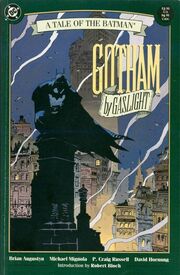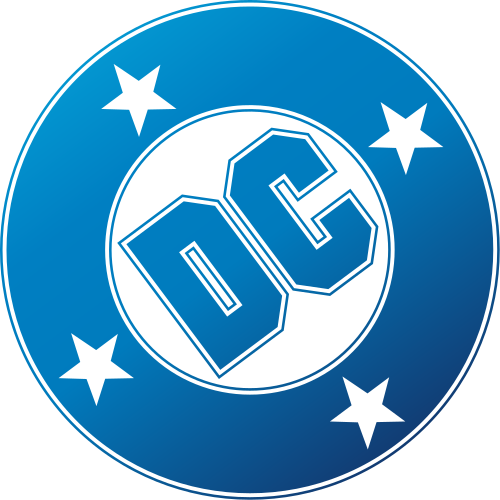(updating links) |
(Templated) |
||
| Line 1: | Line 1: | ||
| ⚫ | |||
| − | |||
{{Quote|In ''Elseworlds'', super-heroes are taken from their usual settings and put into strange times and places - some that have existed, and others that can't, couldn't or shouldn't exist. The result is stories that make characters who are as familiar as yesterday seem as fresh as tomorrow.}} |
{{Quote|In ''Elseworlds'', super-heroes are taken from their usual settings and put into strange times and places - some that have existed, and others that can't, couldn't or shouldn't exist. The result is stories that make characters who are as familiar as yesterday seem as fresh as tomorrow.}} |
||
| + | {{DC Database:Concept Template |
||
| ⚫ | |||
| + | | OfficialName = Elseworlds |
||
| + | | Aliases = |
||
| + | |||
| + | | First = |
||
| + | | HistoryText = |
||
'''Elseworlds''' is the publication imprint for a group of comic books produced by [[DC Comics]] that take place outside the company's canon: |
'''Elseworlds''' is the publication imprint for a group of comic books produced by [[DC Comics]] that take place outside the company's canon: |
||
| Line 12: | Line 17: | ||
For several years from the late 1950s to the mid-1980s, particularly during the 1960s Silver Age of Comic Books era, DC Comics published various stories about their title characters which did not take place in their regular continuity. Most of these stories were labeled "[[Imaginary Stories]]" and featured alternate histories of characters. Although the majority of Imaginary Stories were published in various ''[[Superman]]'' comics, a few Imaginary Stories appeared in ''[[Batman]]'' comics and other DC publications. |
For several years from the late 1950s to the mid-1980s, particularly during the 1960s Silver Age of Comic Books era, DC Comics published various stories about their title characters which did not take place in their regular continuity. Most of these stories were labeled "[[Imaginary Stories]]" and featured alternate histories of characters. Although the majority of Imaginary Stories were published in various ''[[Superman]]'' comics, a few Imaginary Stories appeared in ''[[Batman]]'' comics and other DC publications. |
||
| − | The last official "Imaginary Story" ever published |
+ | The last official "Imaginary Story" ever published - "[[Whatever Happened to the Man of Tomorrow?|Whatever Happened to the Man of Tomorrow?]]"—was written by [[Alan Moore]] and appeared in [[Superman Vol 1 423|Superman (Volume 1) #423]] and [[Action Comics Vol 1 583|Action Comics #583]] (both September 1986). The ''Elseworlds'' series of self-contained stories are essentially Imaginary Stories under a newer label and a wider scope of possibilities. |
===Elseworlds imprint=== |
===Elseworlds imprint=== |
||
| Line 29: | Line 34: | ||
To readers of DC comics, Elseworlds can fall under any writing style not affiliated with the DC comics universe. Titles like ''[[Batman: The Dark Knight Returns|Batman: The Dark Knight Returns]]'' (1986), ''Superman: [[Whatever Happened to the Man of Tomorrow?]]'' (1986), ''The Batman Chronicles'' #21 (May 2000, solicited as Elseworlds, but has no logo), ''Bizarro Comics'' (June 2001, which featured the story "Letitia Lerner, Superman's Babysitter" from the cancelled ''Elseworlds 80-Page Giant''), ''[[Batman: The Dark Knight Strikes Again Vol 1|Batman: The Dark Knight Strikes Again]]'' (2001), and ''[[Superman: Secret Identity Vol 1|Superman: Secret Identity]]'' (2004) were referred to as Elseworlds in the DC Universe without the name brand logo. Except when otherwise noted, most of the stories in the monthly series ''[[Batman: Legends of the Dark Knight Vol 1|Batman: Legends of the Dark Knight]]'' are considered canon, even though some have tales of Batman in the future, which are deemed non-canonical. In 1994, [[DC Comics]] Elseworlds collaborated with the DC yearly summer Annual edition comic books. |
To readers of DC comics, Elseworlds can fall under any writing style not affiliated with the DC comics universe. Titles like ''[[Batman: The Dark Knight Returns|Batman: The Dark Knight Returns]]'' (1986), ''Superman: [[Whatever Happened to the Man of Tomorrow?]]'' (1986), ''The Batman Chronicles'' #21 (May 2000, solicited as Elseworlds, but has no logo), ''Bizarro Comics'' (June 2001, which featured the story "Letitia Lerner, Superman's Babysitter" from the cancelled ''Elseworlds 80-Page Giant''), ''[[Batman: The Dark Knight Strikes Again Vol 1|Batman: The Dark Knight Strikes Again]]'' (2001), and ''[[Superman: Secret Identity Vol 1|Superman: Secret Identity]]'' (2004) were referred to as Elseworlds in the DC Universe without the name brand logo. Except when otherwise noted, most of the stories in the monthly series ''[[Batman: Legends of the Dark Knight Vol 1|Batman: Legends of the Dark Knight]]'' are considered canon, even though some have tales of Batman in the future, which are deemed non-canonical. In 1994, [[DC Comics]] Elseworlds collaborated with the DC yearly summer Annual edition comic books. |
||
| + | | RelatedText = |
||
| − | ==See also== |
||
* [[:Category:Elseworlds|List of Elseworlds publications]] |
* [[:Category:Elseworlds|List of Elseworlds publications]] |
||
* [[Multiverse]] |
* [[Multiverse]] |
||
* [[Hypertime]] |
* [[Hypertime]] |
||
| + | | Notes = |
||
| − | ==External links== |
||
| + | | Trivia = |
||
| + | | Links = |
||
* [http://www.elseworlds.net/ Unofficial Elseworlds Homepage] |
* [http://www.elseworlds.net/ Unofficial Elseworlds Homepage] |
||
* [http://blaklion.best.vwh.net/timelineElse.html Timeline] |
* [http://blaklion.best.vwh.net/timelineElse.html Timeline] |
||
| Line 40: | Line 47: | ||
* [http://members.tripod.com/~YJFAN/Elseworlds.html Fanpage] |
* [http://members.tripod.com/~YJFAN/Elseworlds.html Fanpage] |
||
* [http://jakanapes.com/Alternity/category.php?catId=16 Alternity] |
* [http://jakanapes.com/Alternity/category.php?catId=16 Alternity] |
||
| + | }} |
||
| − | ---- |
||
{{Wikipedia}} |
{{Wikipedia}} |
||
{{DC Comics Imprint}} |
{{DC Comics Imprint}} |
||
| + | |||
| − | {{Template Required}} |
||
{{Nav |
{{Nav |
||
| title = [[Annual Crossovers|Annual Crossover]] |
| title = [[Annual Crossovers|Annual Crossover]] |
||
Revision as of 17:59, 17 November 2008
History
Elseworlds is the publication imprint for a group of comic books produced by DC Comics that take place outside the company's canon:
Unlike its Marvel Comics counterpart What If...?, which bases its stories on a single point of divergence from the regular continuity, most Elseworlds stories instead take place in entirely self-contained continuities whose only connection to the canon DC continuity are the presence of familiar DC characters.
History
"Imaginary Stories"
For several years from the late 1950s to the mid-1980s, particularly during the 1960s Silver Age of Comic Books era, DC Comics published various stories about their title characters which did not take place in their regular continuity. Most of these stories were labeled "Imaginary Stories" and featured alternate histories of characters. Although the majority of Imaginary Stories were published in various Superman comics, a few Imaginary Stories appeared in Batman comics and other DC publications.
The last official "Imaginary Story" ever published - "Whatever Happened to the Man of Tomorrow?"—was written by Alan Moore and appeared in Superman (Volume 1) #423 and Action Comics #583 (both September 1986). The Elseworlds series of self-contained stories are essentially Imaginary Stories under a newer label and a wider scope of possibilities.
Elseworlds imprint
The first Elseworlds title was Batman: Gotham by Gaslight (1989), by Brian Augustyn and Mike Mignola, and edited by Mark Waid, which featured a Victorian Age version of the superhero Batman hunting Jack the Ripper, who has come to Gotham City. This title was not originally published as an Elseworlds comic, but the success of this concept lead to the Elseworlds concept and this title was retroactively declared the first Elseworlds.

Gotham by Gaslight - a tale of the Batman; illustration by Mike Mignola
The first book to feature the familiar Elseworlds logo is Batman: Holy Terror.
DC published various Elseworlds titles on-and-off up to 2004, but as of 2005, no other Elseworlds books have been planned. Around the time of the release of Batman Detective No. 27, editor Mike Carlin noted that DC had scaled back the production of Elseworlds books in order to "put the luster back on them." Several titles that were announced as Elseworlds books prior to this have yet to see publication, such as Generations 4 (Announced by John Byrne, but possibly back-burnered due to lack of good press for & low fan response to Generations 3), Superboy's Legion 2 (rumored sequel by Alan Davis; presumably planned after he finished JLA: Another Nail) and The Teen Titans Swingin' Elseworlds Special (cancelled, possibly due to controversial material concerning John F. Kennedy).
Noted titles
Other Elseworlds titles include JLA: The Nail, which theorizes a world without Superman, in which the Justice League of America has still been formed, but chaos reigns without a proper champion of the world's ideals; I, Joker, where a futuristic Gotham City is led by a cult that follows Batman's descendant, a self-proclaimed god known only as "The Bruce"; and Flashpoint, where Barry Allen (The Flash) takes a bullet meant for John F. Kennedy, paralyzing him from the neck down. In Thrillkiller, Batgirl and Robin fight a female Joker in the 1960's. Superman: Red Son ponders Superman growing up in the Soviet Union and later succeeding Stalin as Soviet Premier.
One of the most famous Elseworlds titles is Kingdom Come, a miniseries in which a new, violent generation of superheroes replaces the aging idealism of DC's classic heroes, and the conflict between the two groups ignites an apocalyptic battle. The Kingdom is the sequel to Kingdom Come.
To readers of DC comics, Elseworlds can fall under any writing style not affiliated with the DC comics universe. Titles like Batman: The Dark Knight Returns (1986), Superman: Whatever Happened to the Man of Tomorrow? (1986), The Batman Chronicles #21 (May 2000, solicited as Elseworlds, but has no logo), Bizarro Comics (June 2001, which featured the story "Letitia Lerner, Superman's Babysitter" from the cancelled Elseworlds 80-Page Giant), Batman: The Dark Knight Strikes Again (2001), and Superman: Secret Identity (2004) were referred to as Elseworlds in the DC Universe without the name brand logo. Except when otherwise noted, most of the stories in the monthly series Batman: Legends of the Dark Knight are considered canon, even though some have tales of Batman in the future, which are deemed non-canonical. In 1994, DC Comics Elseworlds collaborated with the DC yearly summer Annual edition comic books.
Related Articles
See Also
Links and References
| DC Comics Imprint Although at one point it may have been an independent publisher, this company is or was owned by DC Comics, and used as a DC Comics Imprint. This template will categorize articles that include it into the Imprints category. |
| Previous Bloodlines |
Annual Crossover 1994 |
Next Year One |

